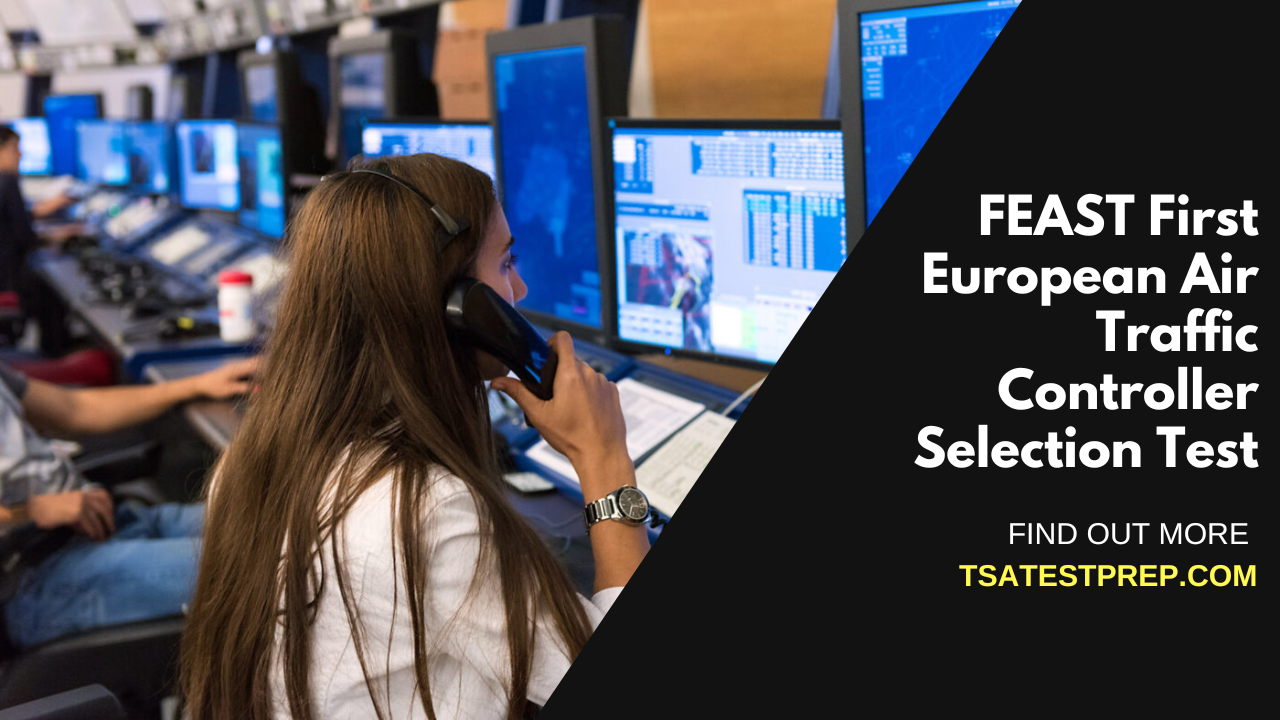
FEAST Practice Test
Are you embarking on a career as an Air Traffic Controller? If you are located in Europe or Canada there is a good chance you will face the First European Air Traffic Controller Selection Test commonly referred to as the FEAST Exam. We are here to walk you through what to expect on the FEAST Exam, provide you study guides, sample questions and detailed explanations.
Learn more with this Online FEAST Practice Test.
What Is the FEAST Test?
FEAST stands for First European Air Traffic Controller Selection Test. It is a series of tests designed by EUROCONTROL, the European Organization for the Safety of Air Navigation, to help Air Navigation Service Providers (ANSPs) ensure that they find the best candidates for the air traffic controller position. The FEAST ATC Test evaluates the knowledge, skills, and abilities of those applying for Air Traffic Control (ATC) positions. The test is broken down into three portions:
- FEAST 1: A series of cognitive ability and English language exams.
- FEAST 2: Two simulations (the DART and the Multipass Test) that assess multitasking in an ATC-related environment. The focus of these exams is to measure your perceptual speed and three dimensional ability.
- FEAST 3: A personality questionnaire.

Depending on the Air Navigation Service Provider (ANSP) you might receive a different combination of these subtests. Some ANSPs may require applicants to take more tests, such as the Wonderlic Assessment provided by Nav Canada. The FEAST is a CHALLENGING assessment that requires high levels of attention and accuracy. Let's take a deeper look at each of the sections.
FEAST I
FEAST 1 Test is made up of 11 aptitude tests that evaluate logical reasoning, attention to fine detail, memory, spatial orientation, and knowledge of the English language. The test can last anywhere between 2.5-4 hours. Luckily you will get a 10-minute break between each subtest. When sitting for the exam, these short breaks are a lifesaver. Take that time to mentally recharge. The FEAST I has a wide variety of questions from multiple choice to think fast questions. It is important to work quickly and accurately, and understand that you may not be able to answer all the questions and that is ok. The FEAST 1 exam includes the following question types:
Cube Folding
In this question type you will be provided a set of squares and asked to show a cube in its folded form. You will only have one minute to answer these questions and these are often considered the hardest questions on the test.
Conflicting Paths
In this scenario, you will encounter multiple triangles representing airplanes positioned in different directions. You will be tasked to analyze whether two triangles are likely to collide or not. If two triangles are facing each other, it indicates an imminent collision course.
Spatial Orientation
You will be presented with images some appearing on screen for as little as 2 seconds. Then asked to answer questions related to space and distance.
Gauges Memorization
You will be presented with a series of gauges and you will have as little as 6 seconds to memorize the information. You will then be asked questions about those images you were shown.
Symbol Memorization
In these scenarios you will face distracting math questions. Your challenge will begin with memorizing 12 symbols. Following that, you will be presented with 15 straightforward math questions. Your task will be to determine whether each math question is true or false. Then, you will be tested on your ability to remember the exact symbols that were first presented to you.
Number Recall
In this memorization task, you will be asked to remember auditory information. Specifically, you will listen to an audio recording where a number is embedded within a sentence. Afterwards, you will be asked to choose the correct number you heard from four potential options. The numbers included can be as high as 9,000,000.
Flight Strategy Test
These questions will measure your aptitude in arranging flight paths based on provided diagrams and given constraints.
FEST II
The FEAST 2 Test is given to ATC candidates who have passed the FEAST 1 assessment. The purpose of the FEAST II is to measure your ability to perform air traffic control tasks in a realistic, simulated environment. These work sample tests can take between 1.5-2 hours to complete. The FEAST 2 is made up of two tests, the DART and Multipass exams.
Multipass Test
The FEAST Multipass Test, also called the Multi Control Test, is an air traffic control simulation that provides scenarios requiring the management of multiple aircraft, responding to potential conflicts, and making quick decisions. The test consists of three types of challenges that must be completed simultaneously:
- You will need to direct aircraft to appropriate landing routes and runways while resolving potential conflicts.
- Manage flight strips.
- Complete an audio task, which includes listening to a recorded sequence of three letters and three numbers (e.g., KDB937) and confirming identical sequences that appear on the screen.
INSIDE TIP: Be PREPARED to encounter a workload of 10-15 aircrafts during the FEAST 2 Multi Control Test When taking this test, your top priority should be resolving conflicts. Keep in mind aircrafts that are at risk of colliding will be highlighted in red, but this does not necessarily mean that you are failing the assessment. Don't let this phase you, potential conflicts are a natural part of the test. It is essential to remain calm and solve the conflicts efficiently to minimize the number of deducted points. On top of conflict resolution, there are other scenarios to pay attention to that can result in point deductions, including handing in an aircraft too late and missing the estimated time of arrival.
Dynamic ATC Radar Test
The FEAST Dynamic ATC Radar Test known as the FEAST II DART Test is an ATC radar simulation that requires you to navigate your aircraft around a set of waypoints without having conflict with other air traffic. The point is to prevent conflicts by providing altitude or heading changes to make sure that all aircrafts avoid each other.
INSIDE TIP: Be READY to work on between 6-10 aircrafts at the same time during the Dynamic Radar Test. Before you start you will get two practice rounds which get progressively harder. Use the practice time wisely. Don't get frazzled if you hear a conflict alarm go off.
FEAST III
The FEAST 3 Personality Questionnaire (FPQ) is designed to measure your personality traits and behavioral characteristics. This last FEAST test may or may not be included in the selection system of some recruiting organizations and can be given at different stages of the recruitment process. Unlike other assessments in FEAST, the FPQ gives the recruiter a sense of you as a person. The personality test usually takes around 30-35 minutes to complete.
Take a Practice ATC FEAST Test.
FEAST Test 1 Example Questions, Answers and Explanations
1. Gauge Memorization Sample Question
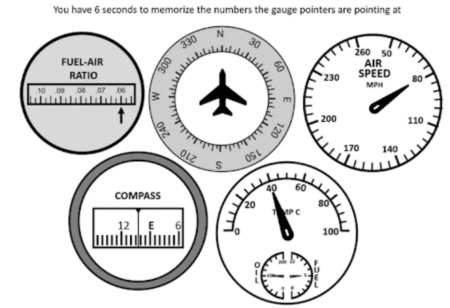
Which of these images appeared on the gauge?
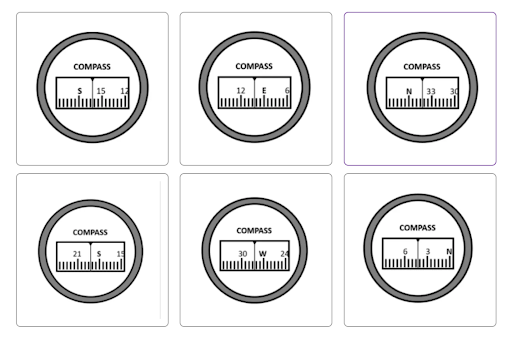
ANSWER + EXPLANATION
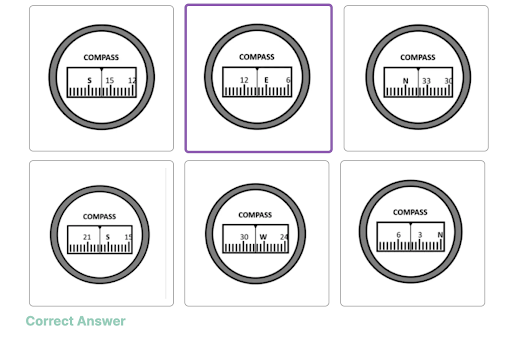
You can feel how short you are actually presented with the initial image.
INSIDE TIP: This challenge is all about memory. If you see numbers on the dials try and repeat them to yourself. If the pointer is pointing to a scale mark with no number, memorize the letter or number closest to it.
2. Flight Strategy Test
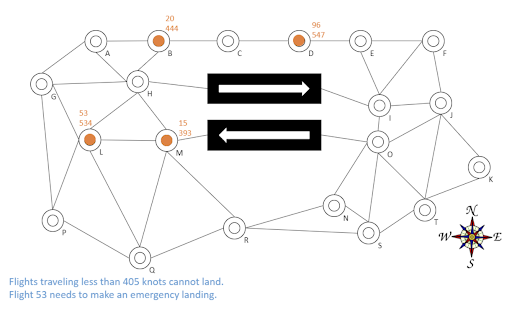
In what order will the flights land?
- 53,96,20
- 96,53,20
- 53, 20, 96,15
- 52,20, 96
ANSWER + EXPLANATION
The answer to this question is (D).
Remember to keep in mind that flights will try to land in the most efficient manner possible, which means they will travel through the fewest checkpoints required to land.
Since flights traveling at a speed of less than 405 knots cannot land, flight 15 will not be able to land. Therefore, we can eliminate option (A).
Flights 20 and 53 are closer to checkpoint H than checkpoint O. Flight 96 is three checkpoints away from both H and O and can land from either checkpoint.
As flight 53 (534 knots) is traveling faster than flight 20 (444 knots), it will reach checkpoint H first. So, the landing order will be 53, 20, 96.
It is worth mentioning that flight 53 would land first even if flight 20 was flying at a faster speed because flight 53 needs to make an emergency landing according to the conditions.
Therefore, the correct answer is (D).
3. Conflicting Paths Sample Question
Determine whether there is a pair of triangles facing each other in a conflicting path.
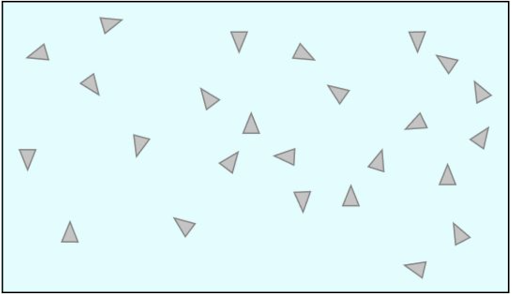
- Conflict
- No Conflict
ANSWER + EXPLANATION
The correct answer is (B) No Conflict. There are no triangles facing each other which means that there are no air crafts in danger of colliding with each other.
4. Cube Folding Sample Question
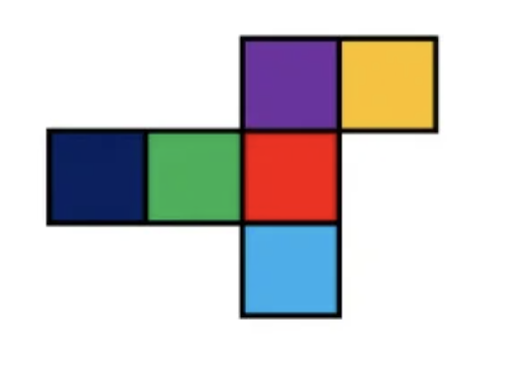

ANSWER + EXPLANATION

To arrive at the correct answer, rotate cube (C) 180 degrees clockwise so that the purple facet is positioned above the red facet. This will show that the green facet is located to the left of the red facet, just as in the unfolded cube. Therefore, cube (C) is the correct answer.
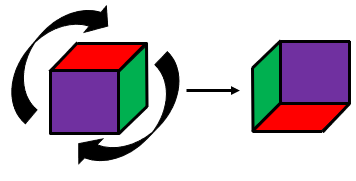
Option (A) is not the correct answer because the red and dark blue facets are located on opposite sides of the cube and cannot make contact with each other.
Option (B) is not the correct answer because the purple and light blue facets are positioned on opposite sides of the cube and cannot touch each other.
Option (D) is not the correct answer because in the unfolded cube, when the red facet is placed above the light blue facet, the green facet is located to the left of the red facet and not to its right, as seen in cube (D).
- On the actual FEAST Cube Test you will have only one minute to complete each of these questions.
- Keep in mind that no facet of the 3D cube will ever come into contact with its opposite facet. This can be useful in eliminating answer options where two opposite facets appear to be adjacent to each other once the cube is folded.
- The most difficult aspect of these types of questions is folding the cube in the correct direction. During the test, you will be instructed to fold the cube in a way that its facets are moving away from you. This method of folding is not as intuitive for many and may require some additional time to master.
As you can see these questions are quite tricky. Practice is essential to help you reprogram your brain to get used to the best strategies to answer the questions. Try this Practice FEAST Test online. It includes tips and tricks for how to tackle the tricky questions under a time crunch.
What Happens if You Fail the FEAST Eurocontrol Test?
According to Eurocontrol, anyone applying for an Air Traffic Control position should aim to take the FEAST ATC test only ONCE. There is an increased chance of failing during the training program for those who failed the exam as compared to those who pass on the first attempt. That being said, different retesting policies are applied for various reasons. In some cases, candidates who fail the FEAST test may be allowed to retake the test after two years, while in other cases, they may not be allowed to take the exam again. The specific consequences of failing the FEAST test varies depending on the Air Navigation Service Provider (ANSP) that administers the test. It is best not to take any chances and review a FEAST Test Simulation before the exam day. Going in prepared can help make the difference between passing and failing.
What Can You Expect on the FEAST Test Day?
On the day of the testing, a test administrator will welcome you and provide guidance throughout the day, explaining everything you need to know before beginning the exams. Before each test, an introduction will be given to explain the principles of the test. You will be given example items and solutions before each subtest. This will give you a chance to answer a sample question to make sure that you understand what is expected of you.
Who Needs to Take the FEAST Exam?
The FEAST Air Traffic Controller Test is used by 54 organizations worldwide. The test is primarily used by European Navigation service providers and NAV Canada Air Traffic Controllers. Over 140,000 individuals worldwide have taken the exam. If you are applying for any of the following positions you can expect to take the FEAST Test:
- Area Controllers (IFR): In this role, you will use advanced equipment to ensure the safe passage of multiple aircraft across different routes. You will be responsible for warning pilots if a plane is flying too fast or if there is not enough distance between two aircrafts.
- Tower Controllers (VFR): These controllers oversee the smooth operation of runways and taxiways. They are also responsible for ensuring that the airspace in and around the airport is well-organized. Depending on the airport, you will be required to work in large groups, so teamwork is important.
- Flight Service Specialists (AAS): Specialists in this role provide pilots with crucial information, such as which runway to utilize. Also, some specialists are responsible for keeping remote airports informed of important information, such as emergency landings.
- Flight Service Specialists (FIC): These specialists function as in-flight weather forecasters. They are are also responsible for leading search and rescue efforts in the event of flights going off course or missing.
What Can You Expect After the ATC FEAST Test?
If you excelled on the FEAST you will be asked to complete a Medical Examination. This is a great sign that you are on your way to a successful air traffic controller career.
How Should I Prepare for the FEAST Test?
Unfortunately, the FEAST exams are long and taxing. Only those candidates who score in the top 30% will move on in the recruitment process. You DO NOT want to take a chance and see what happens if you fail the exam. We highly recommend preparing in advance. We like this FEAST Test preparation pack because it simulates the format of the test to give you the real feel of the exam. Many of the questions on the test are difficult because you face them under pressure and a tight time crunch. Practicing in advance can help you understand those time constraints. Before sitting for a WHOLE day of testing make sure you know what to expect.

Have a Question? Now You Can Ask TSA Test Prep!